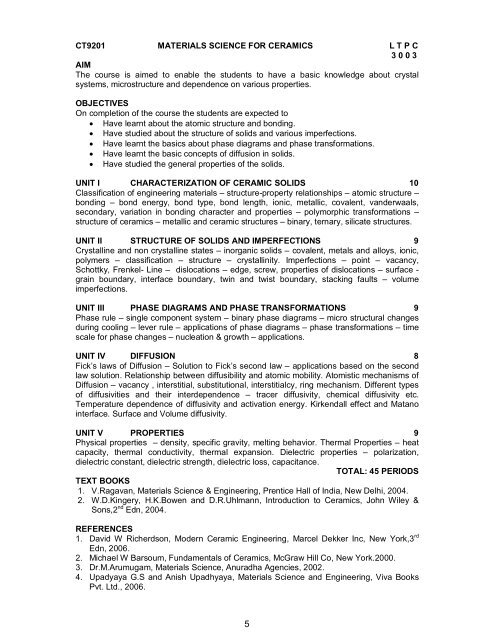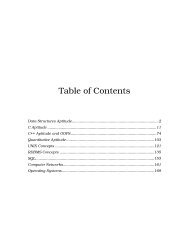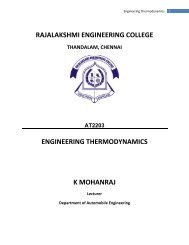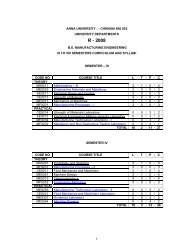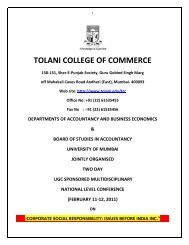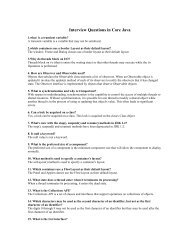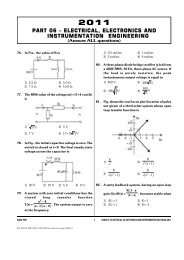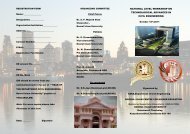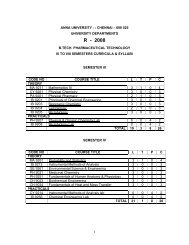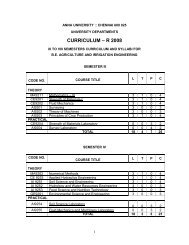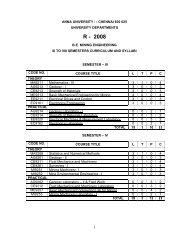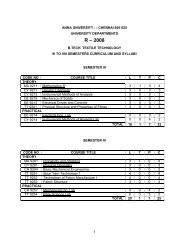b.tech. ceramic technology - Technicalsymposium
b.tech. ceramic technology - Technicalsymposium
b.tech. ceramic technology - Technicalsymposium
You also want an ePaper? Increase the reach of your titles
YUMPU automatically turns print PDFs into web optimized ePapers that Google loves.
CT9201 MATERIALS SCIENCE FOR CERAMICS L T P C3 0 0 3AIMThe course is aimed to enable the students to have a basic knowledge about crystalsystems, microstructure and dependence on various properties.OBJECTIVESOn completion of the course the students are expected to Have learnt about the atomic structure and bonding. Have studied about the structure of solids and various imperfections. Have learnt the basics about phase diagrams and phase transformations. Have learnt the basic concepts of diffusion in solids. Have studied the general properties of the solids.UNIT I CHARACTERIZATION OF CERAMIC SOLIDS 10Classification of engineering materials – structure-property relationships – atomic structure –bonding – bond energy, bond type, bond length, ionic, metallic, covalent, vanderwaals,secondary, variation in bonding character and properties – polymorphic transformations –structure of <strong>ceramic</strong>s – metallic and <strong>ceramic</strong> structures – binary, ternary, silicate structures.UNIT II STRUCTURE OF SOLIDS AND IMPERFECTIONS 9Crystalline and non crystalline states – inorganic solids – covalent, metals and alloys, ionic,polymers – classification – structure – crystallinity. Imperfections – point – vacancy,Schottky, Frenkel- Line – dislocations – edge, screw, properties of dislocations – surface -grain boundary, interface boundary, twin and twist boundary, stacking faults – volumeimperfections.UNIT III PHASE DIAGRAMS AND PHASE TRANSFORMATIONS 9Phase rule – single component system – binary phase diagrams – micro structural changesduring cooling – lever rule – applications of phase diagrams – phase transformations – timescale for phase changes – nucleation & growth – applications.UNIT IV DIFFUSION 8Fick’s laws of Diffusion – Solution to Fick’s second law – applications based on the secondlaw solution. Relationship between diffusibility and atomic mobility. Atomistic mechanisms ofDiffusion – vacancy , interstitial, substitutional, interstitialcy, ring mechanism. Different typesof diffusivities and their interdependence – tracer diffusivity, chemical diffusivity etc.Temperature dependence of diffusivity and activation energy. Kirkendall effect and Matanointerface. Surface and Volume diffusivity.UNIT V PROPERTIES 9Physical properties – density, specific gravity, melting behavior. Thermal Properties – heatcapacity, thermal conductivity, thermal expansion. Dielectric properties – polarization,dielectric constant, dielectric strength, dielectric loss, capacitance.TOTAL: 45 PERIODSTEXT BOOKS1. V.Ragavan, Materials Science & Engineering, Prentice Hall of India, New Delhi, 2004.2. W.D.Kingery, H.K.Bowen and D.R.Uhlmann, Introduction to Ceramics, John Wiley &Sons,2 nd Edn, 2004.REFERENCES1. David W Richerdson, Modern Ceramic Engineering, Marcel Dekker Inc, New York,3 rdEdn, 2006.2. Michael W Barsoum, Fundamentals of Ceramics, McGraw Hill Co, New York.2000.3. Dr.M.Arumugam, Materials Science, Anuradha Agencies, 2002.4. Upadyaya G.S and Anish Upadhyaya, Materials Science and Engineering, Viva BooksPvt. Ltd., 2006.5


